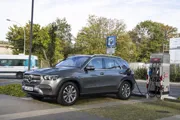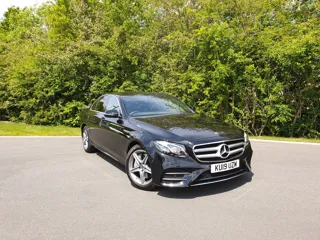Mercedes-Benz has unveiled its GLE 350 de 4Matic (pictured) and GLC 300 e 4 Matic plug-in hybrid SUVs.
The GLE offers an electric-only range of up to 66 miles on the NEDC cycle (WLTP: 56-62 miles), CO2 emissions of 29g/km and fuel economy of 256mpg.
The GLC has an NEDC electric-only range of 29-31 miles (WLTP: 24-27 miles), CO2 emissions of 57-51mpg, and fuel economy of 113mpg to 129mpg.
By the end of 2019, Mercedes-Benz will have more than 10 PHEVs, and aims to offer customers more than 20 model variants in 2020.
It has recently unveiled its EQV fully electric MPV and its A 250 e and B 250 e plug-in hybrids.
GLE 350 de 4Matic
Mercedes-Benz says the considerably longer range of the GLE compared with other PHEVs points the way to an even more rewarding e-driving experience.
The 31kWh battery is accommodated through a special rear-end design and a modified rear axle, meaning there is no step in the floor of the boot, which has a capacity of 1,915 litres.
The SUV has a combined charging socket for AC and DC charging, meaning that at corresponding DC charging stations, the battery can be charged from 10% to 80% in approximately 20 minutes, or 10% to 100% in approximately 30 minutes.
As the largest member of the EQ Power family, GLE has energy recuperation in all four wheels.
THe GLE 350 de uses the same powertrain as the E 300 de that we have on long-term test, which you can read more about here.
GLC 300 e 4Matic
The GLC mid-size SUV also avoids a step in its boot floor, through a lowered rear axle and a bodyshell designed for battery integration.
This gives the GLC PHEV a boot of 395-1,445 litres.
The new model year sees revisions to the GLC’s design, including LED high performance headlamps, as well as the MBUX infotainment system and new driving assistance systems.
As an all-wheel drive SUV, it also has a towing capacity of 2,000kg (braked).
|
|
GLE 350 de 4MATIC |
GLC 300 e 4MATIC |
|
Type/Number of cylinders/Arrangement |
Diesel/4 in-line |
Petrol/4 in-line |
|
Displacement (cc) |
1950 |
1991 |
|
Rated output of combustion engine (kW/hp at rpm) |
143/194 at 3800 |
155/211 at 5500 |
|
Rated torque of combustion engine (Nm at rpm) |
400 at 1600-2800 |
350 at 1200-4000 |
|
Electric motor rated output (kW) |
100 |
90 |
|
Electric motor rated torque (Nm) |
440 |
440 |
|
System output (kW/hp) |
235/320 |
235/320 |
|
System torque (Nm) |
700 |
700 |
|
Acceleration 0-100 km/h (s) |
6.8 |
5.7 |
|
Top speed (km/h)1 |
210 |
230 |
|
Top speed, electric (km/h) |
up to 160 |
over 130 |
|
Fuel consumption combined (l/100 km) |
1.1 |
2.5-2.2 |
|
Combined CO2 emissions (g/km) |
29 |
57-51 |
|
Total battery capacity (kWh) |
31.2 |
13.5 |
|
Combined electrical consumption (kWh/100 km) |
25.4 |
17.8-16.5 |
|
NEDC electric range (km) |
106 |
46-49 |
|
WLTP electric range (km) |
90-99 |
39-43 |

























Login to comment
Comments
No comments have been made yet.